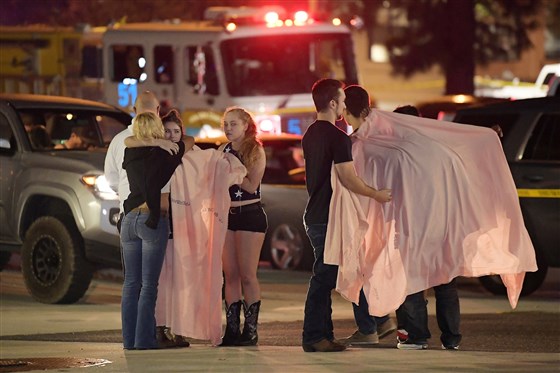
Surviviors from the mass shooting in Thousand Oaks, California comfort one another on November 8, 2018. (Photo: AP)
On November 8, a former Marine who may have had PTSD, opened fire inside a bar, killing 13 and wounding 10 in Thousand Oaks, California.
Before 28-year-old Ian David Long began shooting, he threw smoke bombs into the crowded night spot. During his rampage, he fired at least 30 shots from a legally purchased .45-caliber Glock handgun. Afterward, Long’s body was found, dead from a gunshot wound. It wasn’t immediately clear if Long had committed suicide or was killed by someone else.
There isn't a standard definition for the term “mass shooting.” It is typically applied to gun-related incidents where at least four people, excluding the gunman, are killed by firearms.
Earlier this year, weeks before the summer break was to begin, a 17-year-old white male shot and killed 10 and critically wounded 10 others at Santa Fe High School in Southeast Texas. The 17-year-old student opened fire inside of a classroom using his father’s sawed-off shotgun and pistol.
In response to the school shooting, the US Department of Education said in a statement, “Every day, the Federal Commission on School Safety is working to identify proven ways to prevent violence and keep our students safe at school.” The DoE also emphasized how society would need to work together to address the "underlying issues" that cause school shootings.
Safeguarding classrooms from gun violence has supposedly been the goal of both Democrats and Republicans. Federal funds allocated for education can now be used to purchase weapons and provide firearms training for teachers and school employees.
Earlier this year, the DoE released a study that claimed during the 2015-16 school year there were 235 school shootings in America.
Journalists with National Public Radio (NPR) investigated the report and found that only 11 school shootings had occurred, while 161 had never happened.
One school claimed a school shooting after a student had accidentally left behind a hunting rifle in his car. The gun was never discharged.
Incorrect statics are nothing new from Republicans or Democrats. After a gunman opened fire on a crowd of concert-goers in Las Vegas in 2017 killing over 50 people, Democratic House Minority Nancy Pelosi incorrectly stated there had been a mass shooting in America for 273 consecutive days.
A study from Northwestern University published after the Douglas High School massacre in Florida, a school shooting that claimed 17 lives, found that mass shootings at schools where at least four fatalities occurred are at an all-time low. One of the study’s researchers said, “Four times the number of children were killed in schools in the early 1990s than today.”
The same report also noted how US schools have been dealing with a guidance counselor shortage. Four years ago, the student-to-school counselor ratio was 482-to-1, double the expected standard. With less money spent on counselors and more on security measures, educational institutions will evolve into fortresses, or jails.
Two measures that have shown consistent results in reducing gun-related fatalities include red flag laws and gun permit restrictions.
A red flag law gives law enforcement or a family member the right to report someone they feel is a threat to themselves or others. The person in question is not immediately stripped of their firearms as the process takes weeks before a judge decides the fate of their guns.
In 2005, Indiana became the second US state to implement red flag laws and reported a 7.5 percent drop in gun-related suicides in the same year. Two years later, following a mass shooting at a university in Virginia, gun-related suicides dropped 13.7 percent.
Red flag laws have shown positive results, they offer no guarantees and need further development. California was also one of the first states to pass red flag laws and might have prevented the mass shooting on November 2. Reports have emerged that local law enforcement interviewed Logan at his home last spring after “an episode of agitated behavior that they were told might be post-traumatic stress disorder.”
Gun permit regulations are effective, but they hurt gun sales and make it harder to purchase firearms. Currently, 36 states do not require gun buyers to have a permit. According to Cassandra Crifasi with the Center for Gun Policy and Research at the Johns Hopkins Bloomberg School of Public Health, one study found that firearm homicides dropped almost 14 percent in states that required gun permits.
Days after the Douglas shooting, Wal-Mart and Dick’s Sporting Goods announced they would change their age requirement to purchase firearms from 18 to 21. Both retail chains sell rifles and semi-automatic weapons. Within a week, both companies were slapped with a lawsuit filed by a 20-year old Oregon man citing age discrimination after two store locations prevented him from purchasing a rifle because he wasn’t old enough.
As red flag laws and gun permit regulations have had a positive impact, a focus on those measures would help them develop even further and serve society better, rather than fighting fire with fire by bringing more guns into classrooms.


